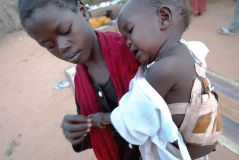Key facts about conflict in Sudan’s Darfur region
LONDON, June 6 (Reuters) – The International Criminal Court launched a formal investigation on Monday into suspected crimes against humanity in Sudan’s Darfur region.

|
|
A 14- year-old Sudanese girl holds her wounded baby brother, hit by shrapnel from an aerial attack in North Darfur, October 2004. Their mother was killed in the bombing attack. (HRW). |
Here are some key facts about the conflict in Darfur:
* Rebels rose up against the government in February 2003 saying Khartoum discriminated against non-Arab farmers in Darfur in favour of Arab tribes. More than 2 million Darfuris, mainly subsistence farmers from a wide variety of ethnic groups, have fled their homes.
* Arab militias known as the Janjaweed drove farmers from their land in a campaign rights groups said amounted to ethnic cleansing and the United States has called genocide.
* The government admits arming some militias to quell the rebellion but denies links to the Janjaweed. It has vowed to disarm them, but the United Nations says Sudan has done very little to neutralise the militias.
* The U.N. estimates at least 180,000 people have died in Darfur from disease and hunger. There are no official tolls of those killed in violence.
* The African Union has about 2,300 troops in Darfur with a mandate to monitor a shaky ceasefire agreed in April 2004 and limited power to protect those displaced in the camps.
* In 2004, a U.N.-appointed commission said crimes against humanity may have taken place in Darfur and drew up a list of 51 people suspected of slaughter, rape and pillage. On March 31, 2005, the Security Council voted to refer war crimes cases in Darfur to the International Criminal Court and later handed over the list of 51 people for investigation.
